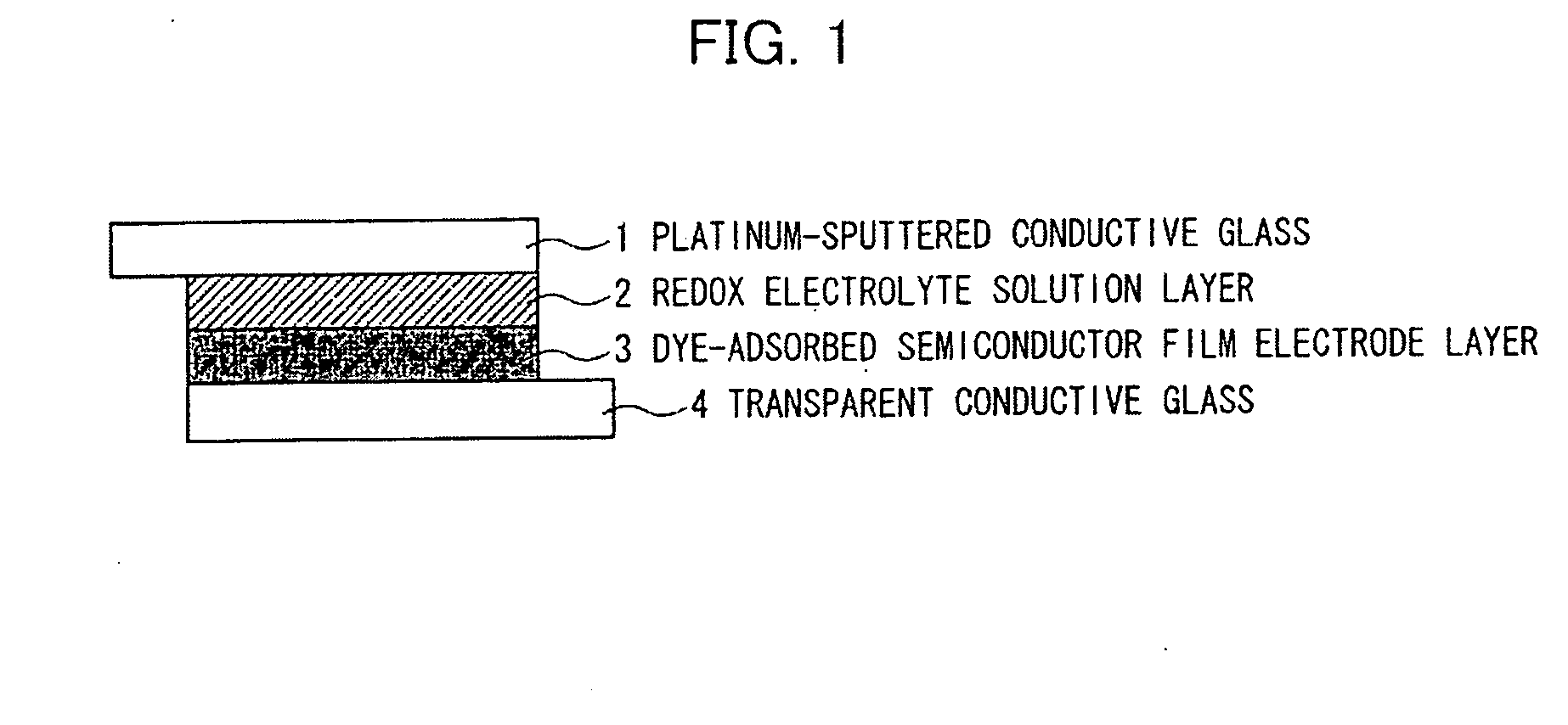Organic compound, semiconductor film electrode employing the organic compound, photoelectric conversion element employing the organic compound, and photoelectrochemical solar cell employing the organic compound
a technology of organic compounds and photoelectric conversion elements, which is applied in the direction of methine/polymethine dyes, electrolytic capacitors, electrolytic generators, etc., can solve the problems of low open circuit voltage and conversion efficiency of dye-sensitive solar cells employing organic dyes, and the limited resources of solar cells, so as to improve the performance of photoelectrochemical solar cells, improve photoelectric conversion efficiency, and raise the open circuit voltage
- Summary
- Abstract
- Description
- Claims
- Application Information
AI Technical Summary
Benefits of technology
Problems solved by technology
Method used
Image
Examples
example 1
Synthesis of Compound No. (5)
[0062]An ether solution of 10 ml (containing a 2-bromo-3-hexylthiophene of 903 mg) was dripped to magnesium of 93 mg. On completion of the dripping, a reaction solution was heated to reflux, so that a grignard reagent was prepared. The reaction solution was cooled down to a room temperature, and [1,3-Bis (diphenylphosphino) propane] nickelchloride of 19 mg was added thereto. An ether solution of 20 ml, containing a 3-iodo-9-ethylcarbazole (represented by Chemical Formula (32)) of 1.12 g, was dripped into the reaction solution, and the reaction solution was agitated for one hour at a room temperature. After that, an ammonium chloride solution was added thereto, and an extraction was carried out with ether. An organic phase thus obtained was washed with water and saturated saline, and dried with magnesium sulfate. Then, the solvent was distilled away therefrom under reduced pressure, so that a crude product was obtained. This crude product was purified by ...
example 2
Synthesis of Compound No. (6)
[0077]A phosphorous oxychloride of 0.1 mL was dripped into a DMF of 1 mL under a cooled condition at a temperature of 0 C.°, and then, agitated for one hour at a room temperature. Thereby, a Vilsmeier reagent was synthesized. The Vilsmeier reagent was dripped into a DMF solution of 5 mL containing a carbazole derivative (represented by Chemical Formula (38)) of 270 mg at a room temperature, and then, agitated for four hours at a temperature of 70 C.°, in which carbazole derivative four hexyl-substituted thiophene rings were fused. After that, the mixture was added with a 10% sodium acetate solution of 30 mL so as to be neutralized, and an extraction was carried out with ethyl acetate. An organic phase thus obtained was washed with water and saturated saline, and dried with magnesium sulfate. Then, the solvent was distilled away therefrom under reduced pressure, so that a crude product was obtained. The crude product was roughly purified by column chromat...
example 3
Synthesis of Compound No. (7)
[0081]A phosphorous oxychloride of 0.1 mL was dripped into a DMF of 1 mL under a cooled condition at a temperature of 0 C.°, and agitated for one hour at a room temperature. Thereby, a Vilsmeier reagent was synthesized. The Vilsmeier reagent was dripped into a DMF solution of 3 mL containing the carbazole derivative (represented by Chemical Formula (39)) of 181 mg at a room temperature, and then, agitated for four hours at a temperature of 70 C.°, in which carbazole derivative five hexyl-substituted thiophene rings were fused. After that, the mixture was added with a 10% sodium acetate solution of 30 mL so as to be neutralized, and an extraction was carried out with ethyl acetate. An organic phase thus obtained was washed with water and saturated saline, and dried with magnesium sulfate. Then, the solvent was distilled away therefrom under reduced pressure, and a crude product was obtained. The crude product was roughly purified by column chromatography ...
PUM
| Property | Measurement | Unit |
|---|---|---|
| particle diameter | aaaaa | aaaaa |
| particle diameter | aaaaa | aaaaa |
| thickness | aaaaa | aaaaa |
Abstract
Description
Claims
Application Information
 Login to View More
Login to View More - R&D
- Intellectual Property
- Life Sciences
- Materials
- Tech Scout
- Unparalleled Data Quality
- Higher Quality Content
- 60% Fewer Hallucinations
Browse by: Latest US Patents, China's latest patents, Technical Efficacy Thesaurus, Application Domain, Technology Topic, Popular Technical Reports.
© 2025 PatSnap. All rights reserved.Legal|Privacy policy|Modern Slavery Act Transparency Statement|Sitemap|About US| Contact US: help@patsnap.com



